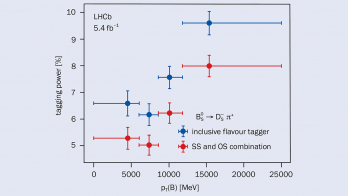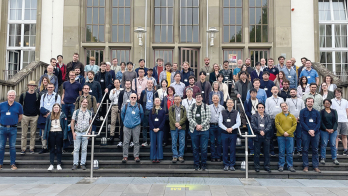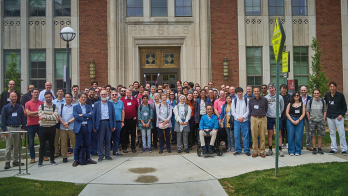The “winter” conferences earlier this year saw the LHCb collaboration present three important results from its increasingly precise search for new physics.
One fascinating area of study is the quantum-mechanical process in which neutral mesons such as the D0, B0 and B0s can oscillate between their particle and antiparticle states. The B0s mesons oscillate with by far the highest frequency of about 3 × 1012 times per second, on average about nine times during their lifetime. In an updated study, the collaboration looked at the decays of B0s mesons into D–s π+ with D–s decays reconstructed in five different channels. While the B0s oscillation frequency Δms has been measured before, the oscillations themselves had been previously seen only by folding the decay-time distribution onto itself at the period of the measured oscillation. In this updated analysis the oscillation pattern is spectacularly visible over the full decay-time distribution, as figure 1 shows. The measured value of the oscillation frequency is Δms = 17.768 ± 0.023 ± 0.006 ps–1, which is the most precise in the world (LHCb collaboration 2013a).
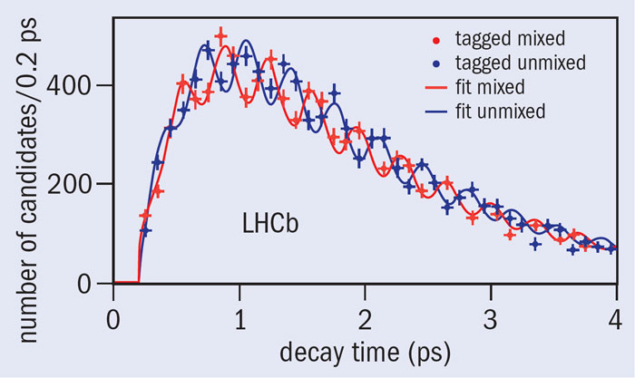
CP violation can occur in the B0s sector – in the interference between the oscillation and decay of the meson – but it is expected to be a small effect in the Standard Model. Knowledge of such CP-violating parameters is important because they set the scale of the difference between properties of matter and antimatter; they may also reveal effects of physics beyond the Standard Model. LHCb has previously reported on a study of B0s decays into J/ψ φ and J/ψ π+π– final states, but now the analysis has been finalized. One important improvement is in the flavour tagging, which determines whether the initial state was produced as a B0s or anti-B0s meson. This decision was previously based on “opposite-side” tagging, i.e. from measuring the particle/antiparticle nature of the other b-quark produced in conjunction with the B0s. The collaboration has now achieved improved sensitivity by including “same-side” tagging, from the charge of a kaon produced close to the B0s, as a result of the anti-s-quark produced in conjunction with the B0s. This increases the statistical power of the tagging by about 40%. The values of the CP-violating parameter φs, together with the difference in width of the heavy and light B0s mass states, ΔΓs, are shown in figure 2, which also indicates the small allowed region for these two parameters, corresponding to φs = 0.01 ± 0.07 ± 0.01 rad and ΔΓs = 0.106 ± 0.011 ± 0.007 ps–1 (LHCb collaboration 2013b)
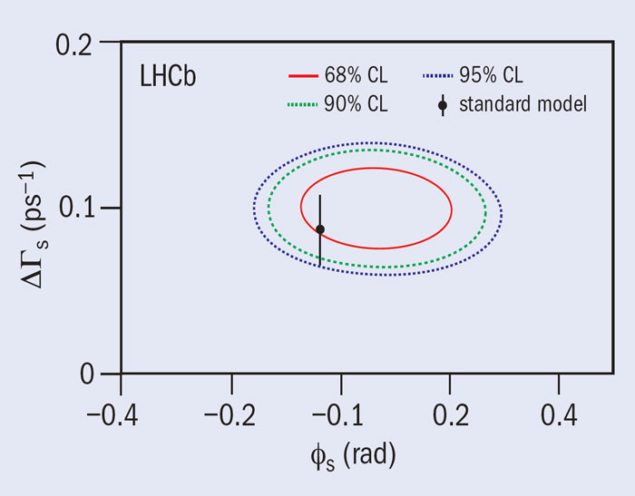
Last, the collaboration has opened a door for important future measurements with a first study of the time-dependent CP-violating asymmetry in hadronic B0s meson decays into a φφ pair, a process that is mediated by a so-called penguin diagram in the Standard Model. Both φ mesons decay in turn into a K+K– pair. The invariant mass spectrum of the four-kaon final state shows a clean signal of about 880 B0s → φφ decays. A first measurement of the CP-violating phase φs for this decay indicates that it lies in the interval of (–2.46, –0.76) rad at 68% confidence level. This is consistent with the small value predicted in the Standard Model, at the level of 16% probability. Although the current precision is limited, this will become a very interesting measurement with the increased statistics from further data taking (LHCb collaboration 2013c)
These results represent the most precise measurements to date, based on data corresponding to the 1 fb–1 of integrated luminosity that LHCb collected in 2011. They are in agreement with the Standard Model predictions and significantly reduces the parameter region in which the signs of new physics can still hide.
Further reading
LHCb collaboration 2013a CERN-PH-EP-2013-054.
LHCb collaboration 2013b CERN-PH-EP-2013-055.
LHCb collaboration 2013c arXiv:1303.7125, submitted to Phys. Rev. Lett.






